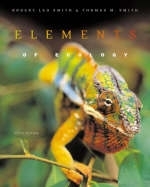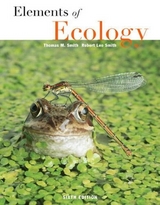
Elements of Ecology
Benjamin-Cummings Publishing Company, Subs of Addison Wesley Longman, Inc (Verlag)
978-0-321-06878-1 (ISBN)
- Titel erscheint in neuer Auflage
- Artikel merken
This book provides readers with a popular modular organization and an easy-to-read writing style that explains the basics of ecology. The authors have updated the Fifth Edition to reflect the current emphasis on the physical environment, global environmental change, and adaptation/evolution. As a result, there are new chapters, a new structure, and new topics found in the table of contents. These changes provide readers with an understanding of the principles governing the relationships between plants, animals, and other living organisms within their environment, and give them skills to critically evaluating public issues related to ecology. Abundant real-life examples illustrate and clarify the book's emphasis on understanding ecological patterns within an evolutionary framework.
Robert L. Smith holds a B.S. in Animal Science, an M.S. in Wildlife Biology along with a Ph.D. in Wildlife Biology from Cornell University. Currently, he is a professor of Ecology at West Virginia University. He has spent over 30 years teaching Ecology and conducting field research throughout the world. His teaching responsibilities have involved mostly undergraduate courses in general ecology and graduate courses in population ecology and wildlife management. His research has included forest-fire related problems in southern West Virginia, vegetational development and succession on abandoned and reclaimed surface mines, the relation between forest vegetational structure and the forest bird community, and forest habitat assessment and habitat evaluation procedures based on vegetational structure. Smith has served as a consultant to congressional committees, workshops on environmental education and energy and environmental problems, the National Landmarks program of the U.S. Department of Interior, National Research Council Task Forces on wildlife and fisheries issues and ecological classification systems for implementing environmental quality evaluation procedures. He is the author of numerous articles and reviews as well as the author of three ecology texts: Ecology and Field Biology, Elements of Ecology and Ecology of Man: An Ecosystem Approach, Harper and Row, New York.
I. INTRODUCTION.
1. Ecology: Background and History.
2. Adaptation and Evolution.
Ecological Application Essay: Selective Breeding and Cloning.
II. THE PHYSICAL ENVIRONMENT.
3. Climate.
4. The Abiotic Environment.
5. Soils.
Ecological Application Essay: The Dust Bowl.
III. THE ORGANISM AND ITS ENVIRONMENT.
6. Plant Adaptations to the Environment.
7. Decomposers and Decomposition.
8. Animal Adaptations to the Environment.
Ecological Application Essay: St. Patrick and Snakes in Ireland.
IV. POPULATIONS.
9. Properties of Populations.
10. Population Growth.
11. Intraspecific Population Regulation.
12. Life History Patterns.
Ecological Application Essay: Human Population Growth.
V. COMMUNITIES.
13. Community Structure.
14. Interspecific Competition.
15. Predation.
16. Parasitism and Mutualism.
17. Processes Shaping Communities.
18. Human Interactions with Communities.
19. Landscape Ecology.
Ecological Application Essay: Asteroids, Bulldozers and Biodiversity.
VI. ECOSYSTEMS.
20. Ecosystems Productivity and Energy Flow.
21. Nutrient Cycling.
22. Biogeochemistry.
23. Human Intrusion into Biogeochemical Cycles.
Ecological Application Essay: Time to Rethink the Lawn.
VII. BIOGEOGRAPHY AND BIODIVERSITY.
24. Biogeography.
25. Grassland to Tundra.
26. Forest Ecosystems.
27. Marine Ecosystems.
28. Freshwater Ecosystems.
29. Wetlands.
30. Global Environmental Change.
Ecological Application Essay: How a Lack of Mushrooms Helped Power the Insustrial Revolution.
| Erscheint lt. Verlag | 21.8.2002 |
|---|---|
| Verlagsort | San Francisco |
| Sprache | englisch |
| Gewicht | 1626 g |
| Themenwelt | Naturwissenschaften ► Biologie ► Ökologie / Naturschutz |
| Technik ► Umwelttechnik / Biotechnologie | |
| ISBN-10 | 0-321-06878-5 / 0321068785 |
| ISBN-13 | 978-0-321-06878-1 / 9780321068781 |
| Zustand | Neuware |
| Haben Sie eine Frage zum Produkt? |
aus dem Bereich



